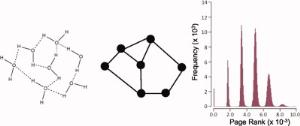
PULLMAN, Wash. - The technology that Google uses to analyze trillions of Web pages is being brought to bear on the way molecules are shaped and organized.
Aurora Clark, an associate professor of chemistry at Washington State University, has adapted Google's PageRank software to create moleculaRnetworks, which scientists can use to determine molecular shapes and chemical reactions without the expense, logistics and occasional danger of lab experiments.
"What's most cool about this work is we can take technology from a totally separate realm of science, computer science, and apply it to understanding our natural world," says Clark.
Clark and colleagues from the University of Arizona discuss the software in a recent online article in The Journal of Computational Chemistry. Their work is funded by the U.S. Department of Energy's Basic Energy Sciences program.
The software focuses on hydrogen bonds in water, earth's most abundant solvent and a major player in most every biological process.
"From a biological or chemical standpoint, water is where it's at," says Clark.
In living things, water can perform key functions like helping proteins fold or organizing itself around the things it dissolves so molecules stay apart in a fluid state. But the processes are dazzlingly complex, changing in fractions of a second and in myriad possible forms.
Much like the trillion-plus Web domains on the Internet.
Google's PageRank software, developed by its founders at Stanford University, uses an algorithm - a set of mathematical formulas - to measure and prioritize the relevance of various Web pages to a user's search. Clark and her colleagues realized that the interactions between molecules are a lot like links between Web pages. Some links between some molecules will be stronger and more likely than others.
"So the same algorithm that is used to understand how Web pages are connected can be used to understand how molecules interact," says Clark.
The PageRank algorithm is particularly efficient because it can look at a massive amount of the Web at once. Similarly, it can quickly characterize the interactions of millions of molecules and help researchers predict how various chemicals will react with one another.
Ultimately, researchers can use the software to design drugs, investigate the roles of misfolded proteins in disease and analyze radioactive pollutants, Clark says.
"Computational chemistry is becoming the third leg in the stool of chemistry," the other two being experimental and analytical chemistry, says Clark. "You can call it the ultimate green chemistry. We don't produce any waste. No one gets exposed to anything harmful."
Clark, who uses Pacific Northwest National Laboratories supercomputers and a computer cluster on WSU's Pullman campus, specializes in the remediation and separation of radioactive materials. With computational chemistry and her Google-based software, she says, she "can learn about all those really nasty things without ever touching them."
Further Information:
Barbara Logan Mooney, L.Rene Corrales, Aurora E. Clark:
MoleculaRnetworks: An integrated graph theoretic and data mining tool to explore solvent organization in molecular simulation.
In: Journal of Computational Chemistry; article first published online: 25 January 2012, DOI 10.1002/jcc.22917
Source: Washington State University, WSU
Last update: 14.02.2012
Perma link: https://www.internetchemistry.com/news/2012/feb12/molecularnetworks.php
More chemistry: index | chemicals | lab equipment | job vacancies | sitemap
Internetchemistry: home | about | contact | imprint | privacy
© 1996 - 2023 Internetchemistry
